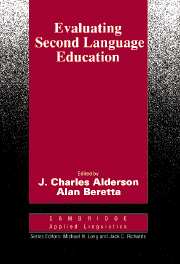Introduction
Published online by Cambridge University Press: 05 October 2012
Summary
This book examines prominent theoretical and methodological issues in the evaluation of second language education. It offers a range of state-of-the-art case studies, a review of the literature showing how the field got to where it is, and practical advice on how to design and execute evaluations in the field.
As a cursory glance at publishers' lists and the contents of the major journals reveals, the discipline of second language education evaluation has been afforded relatively little attention. By contrast, in general social and educational spheres, provision is routinely made for evaluation, and this emphasis is reflected in their respective literatures. One of the most eminent behavioural scientists of the last 50 years has devoted two recent books to the subject (Cronbach 1982, Cronbach et al. 1980) and has called evaluation ‘the liveliest frontier of American social science’ (1980:13).
In second language education, there has long been dissatisfaction with evaluation which has been methodologically inflexible and uncertain or misguided as to its role. If the published literature is at all representative, it has not been a lively frontier.
This edited collection is designed as a first step in bringing the evaluation of second language education to the cutting edge.
Specifically, this book offers commentary and data intended to foster a self-reflecting attitude in researchers already involved in evaluation and to provide useful input to teacher-training programmes.
In designing the book, it was judged that what an evaluator really needs to know is how to deal with ad hoc investigation that appears to have no tradition that can be appealed to.
- Type
- Chapter
- Information
- Evaluating Second Language Education , pp. 1 - 4Publisher: Cambridge University PressPrint publication year: 1992

